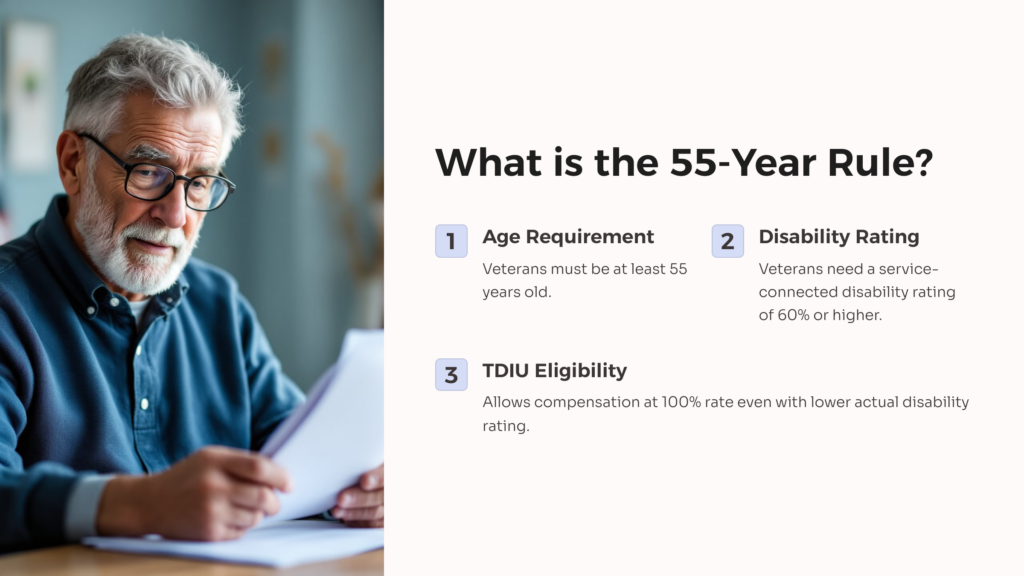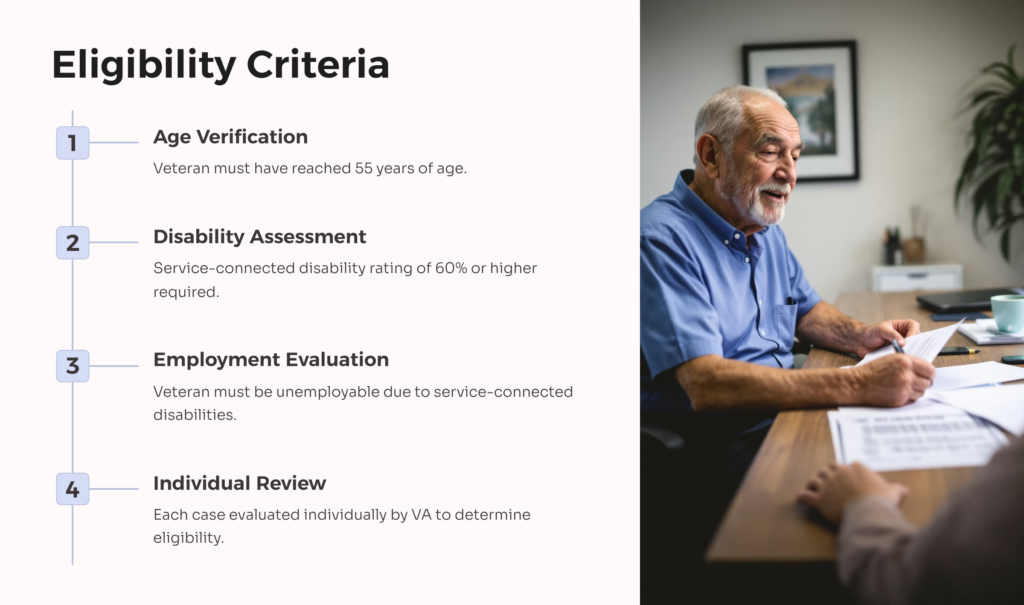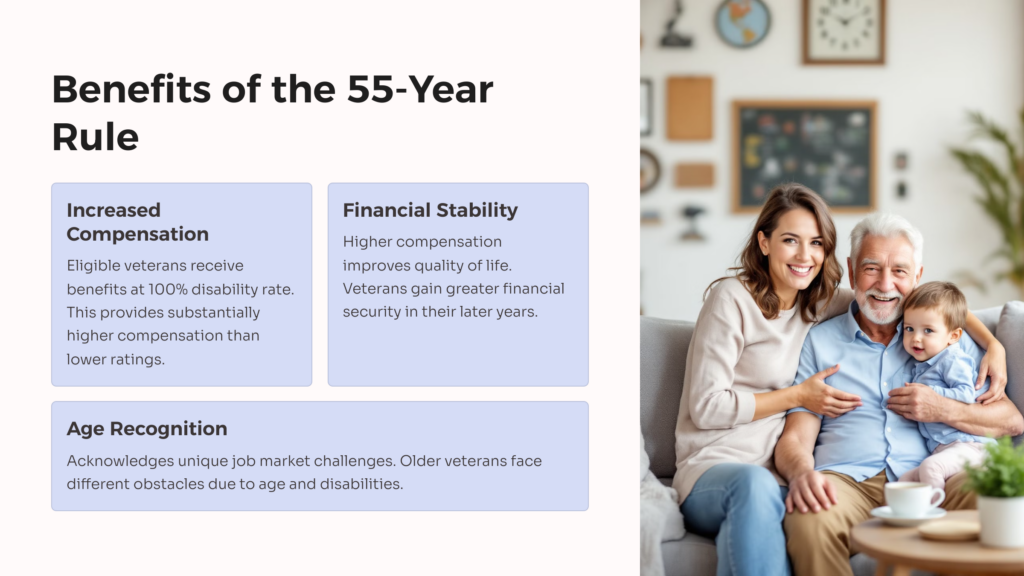The 55-Year Rule is an important concept for veterans to understand when it comes to their benefits. This rule can have a significant impact on the financial support available to veterans and their families. Let’s dive into what the 55-Year Rule means and how it affects veteran benefits.

The 55-Year Rule refers to a provision in the Department of Veterans Affairs (VA) regulations that allows certain veterans to receive additional compensation. This rule applies to veterans who are at least 55 years old and have a service-connected disability rating of 60% or higher. Under this rule, these veterans may be eligible for Total Disability based on Individual Unemployability (TDIU) benefits.
TDIU is a VA benefit that allows veterans to receive disability compensation at the 100% disability rate, even if their actual VA disability rating is less than 100%. This benefit is designed to support veterans who are unable to maintain substantially gainful employment due to their service-connected disabilities.
Eligibility Criteria for the 55-Year Rule

To qualify for benefits under the 55-Year Rule, veterans must meet specific criteria. These requirements ensure that the benefits are provided to those who truly need them due to their age and service-connected disabilities.
The primary eligibility criteria for the 55-Year Rule include:
- Age requirement: The veteran must be at least 55 years old.
- Disability rating: The veteran must have a service-connected disability rating of 60% or higher.
- Employment status: The veteran must be unemployable due to their service-connected disabilities.
It’s important to note that meeting these criteria doesn’t automatically guarantee approval for TDIU benefits. The VA will still evaluate each case individually to determine if the veteran is truly unable to maintain substantially gainful employment due to their service-connected disabilities.
Benefits of the 55-Year Rule

The 55-Year Rule can provide significant advantages for eligible veterans. Understanding these benefits can help veterans make informed decisions about their VA claims and financial planning.
One of the main benefits of the 55-Year Rule is the potential for increased VA disability compensation. Veterans who qualify for TDIU under this rule can receive compensation with a 100% VA rating, which is substantially higher than the rate for a 60% or 70% disability rating. This increase in compensation can make a significant difference in a veteran’s quality of life and financial stability.
Additionally, the 55-Year Rule recognizes that older veterans may face unique challenges in the job market due to their age and disabilities. By providing access to TDIU benefits, this rule helps ensure that these veterans receive the support they need, even if they don’t meet the traditional criteria for a 100% VA disability rating.
How to Apply for Benefits Under the 55-Year Rule
Applying for benefits under the 55-Year Rule requires careful preparation and documentation. Veterans should follow these steps to ensure the best chance of approval:
- Gather necessary documents: Collect medical records, employment history, and any other relevant documentation that supports your disability claim.
- Complete VA Form 21-8940: This form, also known as the Veteran’s Application for Increased Compensation Based on Unemployability, is crucial for TDIU claims.
- Submit additional evidence: Provide any additional evidence that demonstrates how your service-connected disabilities affect your ability to work.
- File your claim: Submit your completed application and supporting documents to the VA. This can be done online, by mail, or in person at a VA regional office.
- Follow up: Stay in touch with the VA regarding the status of your claim and provide any additional information they may request promptly.
Remember, the application process can be complex, and it may be helpful to seek assistance from a Veterans Service Organization (VSO) or a VA-accredited attorney to guide you through the process.
Common Misconceptions About the 55-Year Rule
There are several misconceptions about the 55-Year Rule that can lead to confusion among veterans. It’s important to clarify these misunderstandings to ensure veterans have accurate information when considering their VA disability benefits.
One common misconception is that the 55-Year Rule automatically grants TDIU benefits to all veterans over 55 with a 60% disability rating. In reality, the rule simply makes it easier for these veterans to qualify for TDIU, but approval is not guaranteed. The VA still evaluates each case individually to determine if the veteran is truly unemployable due to their service-connected disabilities.
Another misconception is that veterans must be completely unemployed to qualify for TDIU under the 55-Year Rule. While TDIU is generally intended for veterans who cannot maintain substantially gainful employment, there are exceptions for marginal employment. Veterans engaged in marginal employment may still be eligible for TDIU if their income is below the poverty threshold.
Challenges and Limitations of the 55-Year Rule
While the 55-Year Rule can be beneficial for many veterans, it’s important to understand its limitations and potential challenges. Being aware of these factors can help veterans navigate the application process more effectively and set realistic expectations.
One challenge is the complexity of proving unemployability. Even with the 55-Year Rule, veterans still need to demonstrate that their service-connected disabilities prevent them from maintaining substantially gainful employment. This can be particularly challenging for veterans who have been out of the workforce for an extended period or those with multiple disabilities that interact in complex ways.
Another limitation is that the 55-Year Rule doesn’t apply to all types of VA benefits. For example, it doesn’t affect eligibility for VA pension benefits or service-connected disability compensation rates for ratings below 60%. Veterans should carefully consider how applying for TDIU under this rule might impact their overall benefits package.
Tips for Maximizing Benefits Under the 55-Year Rule

To make the most of the 55-Year Rule and increase the chances of a successful TDIU claim, veterans should consider the following tips:
- Maintain detailed medical records: Keep comprehensive records of all medical treatments related to your service-connected disabilities. This documentation can be crucial in demonstrating the impact of your disabilities on your ability to work.
- Seek regular medical evaluations: Regular check-ups and evaluations can provide up-to-date evidence of your disability status and its effects on your employability.
- Be honest about your limitations: When applying for TDIU, be clear and honest about how your disabilities affect your daily life and ability to work. Downplaying your symptoms could hurt your claim.
- Consider vocational expert opinions: A vocational expert can provide professional insight into how your disabilities affect your ability to perform in various job settings.
- Stay informed about VA regulations: Keep up-to-date with any changes in VA regulations that might affect your eligibility or benefits under the 55-Year Rule.
The Future of the 55-Year Rule and Veteran Benefits
As with many aspects of veteran benefits, the 55-Year Rule and related policies may evolve over time. It’s important for veterans to stay informed about potential changes that could affect their benefits.
Several factors could influence the future of the 55-Year Rule, including:
- Changes in VA policies and regulations
- Shifts in the job market and employment trends for older workers
- Advancements in medical treatments for service-connected disabilities
- Budget considerations and funding for veteran benefit programs
Veterans should stay connected with veteran support organizations, regularly check the VA website for updates, and consult with VSOs or VA-accredited attorneys to stay informed about any changes that might affect their benefits.
By understanding the 55-Year Rule and staying informed about veteran benefits, older veterans can ensure they receive the support they’ve earned through their service. While navigating the VA system can be challenging, the potential benefits of programs like TDIU can make a significant difference in the lives of veterans and their families.
Allow us to jumpstart your benefits today! Get started by taking our free medical evidence screening at Allveteran.com.
 AllVeteran.com Advisors
AllVeteran.com Advisors
With expertise spanning local, state, and federal benefit programs, our team is dedicated to guiding individuals towards the perfect program tailored to their unique circumstances.











